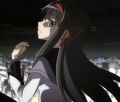Madoka Magica Episode 12: My Very Best Friend
Please refrain from reading if you haven't watched the latest episode yet.
"Don't forget.
Always, somewhere,
someone is fighting for you.
--As long as you remember her,
you are not alone." - ending sequence.
| My Very Best Friend わたしの、最高の友達 | |
|---|---|
| First airing | 21 April 2011 |
| Script | Gen Urobuchi |
| Storyboard | Shinsaku Sasaki |
| Episode director | Yukihiro Miyamoto |
| Animation Director | Jun'ichirō Taniguchi Mika Takahashi |
Summary
The episode starts with Madoka comforting an injured Homura, telling her that she finally understands what Homura had gone through and promising to take care of everything, despite Homura's anguish at the prospect of seeing Madoka become a witch. Madoka then stands up and, at Incubator's urging, finally makes her wish: "II wish I had the power to erase witches before they’re born. Every single witch from the past, present and future, everywhere.". As promised by Kyubey,[1] her wish is granted and she becomes a goddess, breaking the Incubators' system at the same time. The next half of the episode is an in-depth animation of said transformation.
The first sequence is a short discussion with Kyoko and Mami: Mami warns Madoka of the consequences of her wish, while Kyoko encourages her in her usual forceful way. Madoka is then seen travelling through space and time, healing defeated magical girls (among which we can see historical figures such as Anne Frank, Cleopatra, and Joan of Arc).
The consequence of her becoming a Magical Girl quickly follows the "rescue" of the other magical girls: due to her wish, the laws of nature have been altered, and the old world will be put to an end in order for a new one to take its place. Homura witnesses the Earth being swallowed in despair from the moon, where she also sees Madoka's soul gem, now the size of an asteroid, traveling through space.
The gigantic soul gem collapses into a Grief Seed and Madoka's new planet-sized Witch form is unleashed: However, true to her word, she erases her own Witch from existence. The resulting paradox removes Madoka from the universe.
The cosmic sequence continues with Madoka losing her physical humanity to become a force of nature, detached from mankind; however, she is now suspended in inter-dimensional space, in contact with everyone and everything. After a sequence highly open to interpretation, she finally parts with a tearful Homura, giving her her ribbons as a souvenir with the promise that they may meet again.
The scene cuts to an audition where Kyousuke is playing Charles Gounod's Ave Maria. In two of the seats in the audience are the spirits of Madoka and Sayaka. Madoka apologizes for causing Sayaka trouble, and says that she believes her sacrifices were not in vain. Sayaka responds that she only wanted to hear Kyousuke play one last time, as many more would come to see him in many years to come; she states that she has no regrets and that she believes Hitomi (who is hiding behind the curtain watching the performance) and Kyousuke will be a happy couple, and that while it still hurts a little to see them together, she cannot hold it against them anymore. The two get up and depart, and the scene cuts to Kyousuke as a famous violinist; as the audience applauds for him, he is struck by a memory of the hospital and says Sayaka's name.
Mami and Kyoko, now alive, fight a creature together (revealed later to be a "wraith"), and find that Sayaka had used the last of her magic to help Kyousuke and thus disappeared from existence. Mami reflects on how the fate of a magical girl is to disappear before they can cause grief; Homura, wearing the ribbon and thinking of Madoka, says her name and starts crying, and it is revealed that nobody in this world remembers Madoka but her. Homura later sees Tatsuya drawing a picture of Madoka in the sand; she talks to Madoka's parents and find that they also have no memory of their daughter, though she seems to manifest as Tatsuya's imaginary friend. Junko comments that the name Madoka feels nostalgic.
Homura then discusses her story with Kyubey, who says that it's possible everything Homura went through could be her imagination, and there would be no way to prove otherwise. However, he remarks that the concept of harvesting witches for energy would be more efficient than the new method: because there is still grief in the world, it manifests in the form of wraiths that the magical girls must fight, who upon defeat drop cube-shaped pieces much like Grief Seeds. Homura reflects on the new universe, thinking that this corrupted, grief-filled world is what Madoka sought to protect -- but she will never forget Madoka's wish. She then leaps upon the wraiths, extending wings of light from her back and carrying a bow and arrow.
After the credits, Homura walks through what looks like either a wasteland or a barrier towards a bunch of wraiths. Black wings sprout from her back, containing distorted images that resemble those of a witch's barrier; Madoka's voice encourages her, and Homura springs upon them to fight.
And with some hopeful words, Puella Magi Madoka Magica comes to an end.
Runes
Audio Commentary
See Also: Guidebook staff commentary from the Magica Quartet
| My Very Best Friend わたしの、最高の友達 | |
|---|---|
| Commentary | Aoi Yuuki Chiwa Saitou Gen Urobuchi Ume Aoki Yukihiro Miyamoto |
The final commentary has all of the staff who's been on, in addition to Aoi Yuuki and Chiwa Saitou. That's Gen Urobuchi, Ume Aoki, and Yukihiro Miyamoto.
The first thing they ask the staff is whether this ending was planned from the start. Gen says that most of the scenario was used without modification. However, they took liberties with things like the space scenes.
Saitou asks about the overall background style, how the backgrounds are wide open. Was that intended from the beginning? Urobuchi said that they had planned that, but Gekidan Inu Curry helped influence the final feel.
Next, Yuuki asks about Madoka's wish: do they think that it's 'correct'? Urobuchi says that he can't say it's not right; it's quite something for a middle school girl. Aoki says that Madoka was able to really gather a lot of experiences together before making her decision.
Urobuchi then cuts in saying that he really wanted to have that scene where Mami gives Madoka her sketches back.
Miyamoto really liked her wish. She really isn't saving the whole universe or the world, just the mahou shoujo. Yuuki thought that without Homura, they couldn't have had this wish.
Urobuchi then talked about the scene with Madoka saving all the girls. "Was it okay to do something this flashy?" Saitou then says that before this she hadn't considered that there were magical girls all over the world. Urobuchi says "Kyubey is world-wide."
It's amazing though, she's saving every magical girl not just around the world but the past and the future. Madoka really has a lot of work to do!
Saitou says that she really likes the warm, kind acting that Yuuki did here. (So do I.) Yuuki said that she was trying to avoid being too 'goddess-like'; as a girl she would actually find it painful and difficult, so she was trying to balance that with the kindness. Saitou said that she meant to talk more about it during episode 11's commentary, but here she says she really likes how Homura confessed that she's from the future. It's the first time she really was able to let out everything she was holding back. But as a result, Madoka made her decision based on that. Urobuchi said in response that in the end, he was intending it to be a story about Madoka and Homura. Aoki adds that she was super happy when she told Homura that she now knows everything; she knows everything that Homura went though.
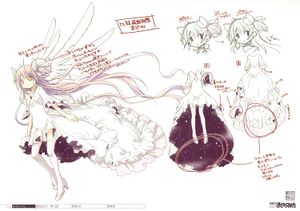
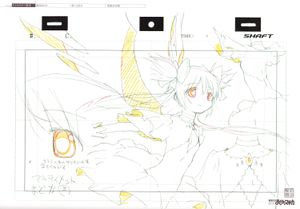

Next they talk about Godoka. So cool! She actually only shows up only once; Urobuchi was worried that it wouldn't be enough, but she really made an impression. Yuuki says "Of course, she's Hyper Ultimate Madoka!" (apparently that was actually written in the setting by Urobuchi when he was playing around) The skirt is the whole universe. Everyone really wanted to see it. Aoki did the design for it, but she just did whatever she felt like. She worried about whether it would be too tough to animate though. Apparently, the character designer spent several pages trying to figure out how best to adapt it to animation, even though it was only used once.
Then they're in space talking to each other. Madoka knows everything now, but Homura still is worried about her. How dedicated, says Saitou. Aoki says that at the beginning, Madoka was really self-deprecating, but now she's a special existence.
Saitou says that because this isn't a romantic relationship, it turned out differently. They're able to think about each other more selflessly. Also, if it were two guys, it'd be like "Good luck!" More like Gurren Lagann.
Here they talk about how Urobuchi really understands the way girls think. Is he a girl? They really like talking about that. The way the girls grow up through experiencing pain. Yuuki does say that Madoka is still unable to save people who were selfless; like Sayaka, who still died in this world. But she's probably still glad.
Then's the scene with Homura, Mami, and Kyouko. Saitou says that they're the least related in the story. They're the only ones that don't become witches in the story either, adds Urobuchi.
And then there's the scene with Tatsuya who seems to still remember Madoka. Saitou says that it'd probably be too hard if her parents remembered her though. But Urobuchi said that he's probably not remembering her, but rather actually seeing her, like a cat seeing things. Kids are more perceptive of things like that.
They're glad they get to see everyone's reactions, sorta. But at the same time, it's really sad.
And now we have the scene with Kyubey. Kyubey's past methods of deception and tricks are no longer necessary, so now he has a better relationship with magical girls as a normal ally. Madoka didn't erase curses themselves, but rather the witches. But now there's a new mechanism and there still have to be magical girls to be fight them. He'd be more forthgiving with information, like how you'll have to work hard and you'll disappear if you don't keep your soul gem clean.
Now they ask their last impressions. Miyamoto says that he really wants a season two. Aoki says that she was only useful until halfway through, but she was glad to be part of the staff. Urobuchi then says that this was the first time he wrote for anime, but he really liked the freeedom. Now, he's frantically looking forward to the next work. Second season maybe, the seiyuu ask? He says maybe, but he's not sure yet. He apparently had shown Aoki Ume some of the plot. She says "Urobuchi doesn't hand out happiness so easily..."
Finally, Saitou thanks Urobuchi for the work. She said that she'd never enjoyed playing a role as much as this before. Yuuki says that she thought she was really able to grow as a part of this.
And then finally, they thank you!
Trivia
- At a Nico Character interview, Urobuchi defined Madoka after her wish as becoming "the rules that governed the world of the series" and Homura as "an evangelist who is the only person within the world she lives in who understands Madoka's existence and role."
- In the Audio Commentary for Episode 12, Urobuchi explained that the reason Tatsuya knows about Madoka is because he can see her. He says it's how little children can see things they're not suppose to, because they don't know they're not suppose to see it. Sadly, Urobuchi also said when he grows up, he won't be able to anymore and will likely forget all about it.
- Urobuchi doesn't know the meaning of Homura's black wings as they were never mentioned in his script, and instead they were added by Gekidan Inu Curry, the production designers for the series. He hinted that the meaning behind the wings may be explained in the Madoka Magica movie trilogy.
- In the Audio Commentary for Episode 12, when Madoka meets Mami and Kyoko for the last time, Urobuchi states that Madoka is meeting with people that have nothing to do with space and time. This can be interpreted as Madoka meeting with their spirits as a final farewell.
- Urobuchi states in the commentary that Madoka erased the existence of Witches but did not erase curses themselves.
- When Ume Aoki asked Gen Urobuchi if Kyubey would still hide the fact that a Soul Gem would disappear if a magical girl dies. Gen Urobuchi responded that Kyubey may actually mention that information to girls making a contract. He also added that Kyubey would carefully word it to an extent as it would be cumbersome to have girls trying go around without their Soul Gem.
- In the official subs and the English dub, the demons are called "Wraiths".
Observations
- Once again, this episode used Connect as an ending song. However, there was no animation sequence, as instead the credits rolled in black on a white background.
- This episode doesn't have a proper opening either.
- This episode ends with a sequence showing first the backs of Madoka, Kyoko, Sayaka, Homura, and Mami followed by the silhouettes of all magical girls which appeared in the anime -- even those which were only shown in their witch forms. After that, Madoka´s ribbon falls, and her soul gem is shown for a second.
- This episode does not have an end card, neither in the blu-ray nor the TV version. However, the official website lists an art by Ume Aoki, the series' character designer, as the series' final end card.
- According with some fans the end of Episode 12 is considered a "Lain" ending. Madoka is the Jesus figure, Homura is her prophet, and Kyubey is the Devil (analogous to the Temptation of Christ). Others have dubbed the ending a "Reverse Evangelion" ending. In Neon Genesis Evangelion, all of humanity becomes a higher being except the protagonist(s), while in Madoka's ending, the protagonist becomes a higher being while everyone else maintains a regular existence.
- Mami, as the veteran and Madoka's mentor, could be considered a John the Baptist figure for obvious reasons.
- In a recent interview, Urobuchi clarified the following about the ending:
- The setting is not in Japan
- Homura is continuing to battle on in the rest of the world
- Scene is a homage to "Blade"
- Fan theories in interpreting the ending, such as "Homura is the only magical girl remaining," surprised him.
- Even if there are no witches in the world, the magical girls have to fight against wraiths now. Therefore Kyubey can still gain energy to fight against entropy.
- The Incubators have been on the earth since the stone ages. According to Kyubey, humans would still live in caves if his species had not granted girls' wishes over time.
- Madoka has changed the laws of the universe, thus changing the magical girl system and humanity's relationship with Incubators: Witches do not exist on that world as spent Soul Gems disappear mysteriously before they can curse the world. However, curses continue to haunt humanity in the form of Magical Beasts or Wraiths of unknown origin; it is the role of magical girls to defeat these monsters, gather their curses in the forms of small cubic fragments (Grief Cubes?), and have them harvested to slow the effects of entropy. Magical girls who overexert their magical powers will die (or disappear), so they must use the dark cubes to purify their Soul Gems before that happens. Apparently, Homura and Kyubey now have a better relationship in this new reality because of the new nature of the universe. Since Incubators cannot harvest Grief Seeds from Witches (as they do not exist), they don't induce despair from magical girls for it has no effect on fixing entropy; Kyubey admits that if it was the opposite, the nature of Incubators would be a kind of different.
- According with magazine interviews, all magical girls share the same fate of fading away, the same will be true with Homura, Kyoko, and Mami. It is stated that Madoka will take their spirits to "another universe", many interpret this other universe to be an afterlife.
Other Magical Girls
| Screencap | Notes |
|---|---|
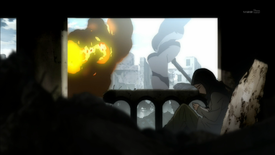
|
A girl with her head covered, praying with her Soul Gem in her hands in the middle of a modern battlefield. Identity unknown, but speculated to be Muslim as she is wearing a hijab. She could perhaps be National Geographic's "Afghan Girl", Sharbat Gula |
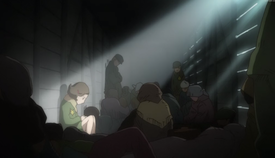
|
A Jewish girl wearing a yellow star on her clothes and holding a Soul Gem while riding a cargo train to a concentration camp. Fans believe she could be the Jewish-German Anneliese Marie "Anne" Frank, riding a train towards Bergen Belsen Concentration camp. |
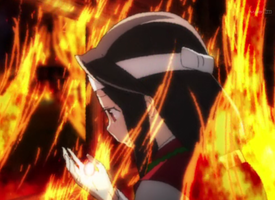
|
Queen Himiko. A girl with long black hair and robes similar to those used by Shinto priestesses in modern Japan. Himiko was the head shaman and queen of Yamataikoku, one of the first realms in what would later become Japan, and a controversial figure in Japanese history ever since the Tokugawa period. |
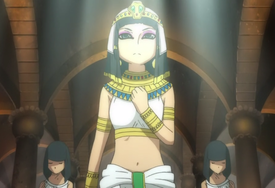
|
Cleopatra, Queen of Egypt. Possibly getting ready to face the Battle of Actium. |
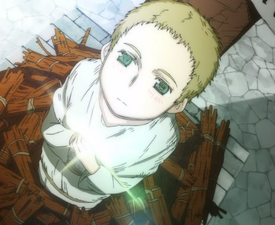
|
Joan of Arc, before she is burned alive on May 30, 1431. |

|
Madoka's first rescue. This girl is speculated to be the Dakini princess who, according to Himalayan legend, came from Arunachal Pradesh in northeast India to Tashiyangtse, Bhutan in the 18th century. She is supposed to have subdued a wraith by allowing herself to be entombed alive in Chorten Kora, the white monument shown behind her. Also, there are the Himalayan prayer flags. |

|
This girl is located on a savanna. |
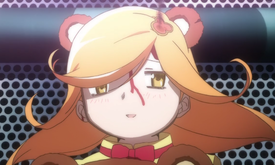
|
A girl wearing a bear costume located in a futuristic city or theme park. |
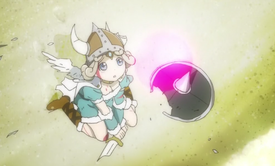
|
A girl wearing stereotypical viking garb positioned on a beach or island. It is unknown whether she is an actual viking or not, but judging by the weapons strewn about her, the theory is likely. |
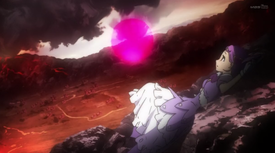
|
A girl in a purple dress located in a volcanic region. It's speculated said volcano may be either Mount Vesuvius (of Pompeii fame) or Mount Etna. |
Production errors
Even though Shaft had an extra month to check the quality of the episodes, the TV broadcast had at least one production error.
-
Homura has 6 fingers here
Speculations
Please keep in mind that they are fanmade theories, and not official material.
- Cleopatra and Joan d'arc were magical girls. ...perhaps Anne Frank too?
- There is one sequence where a girl inside a train cargo is wearing a yellow star, fans assume she could be Anne Frank as she shares some similarities.(See Above)
- Though Madoka purifies every curse before it bears a witch, still there must be a causal kickback of each wished miracle. Curses accumulate in Madoka's gem but she can interrupt even her own corruption. One possible origin of wraiths is those wandering despair, and it should lead as followed; as magical girls increase (whether in number or power), so do wraiths.
- Kyubey informs Homura that the wraiths have been agitated as of late, causing more frequent attacks on humans. He doesn't explain the reasons for it as he probably doesnt know the cause...
- As the producer explained that "witches were eliminated but not curses", "wraiths" might just be manifestations of those curses in an alternative form. Nothing very complex here.
- Mami describes the process in which magical girls vanish as "円環の理 (Enkan no Kotowari: Law of Cycles)", roughly corresponding with the name of 鹿目まどか (Kaname Madoka: Vital Circle).
- It is suggested that girls prior to becoming magical girls are aware of the consequences and the process involved of becoming one. Girls are given the option to consent once they are fully aware of the consequences.
- There are many speculations regarding the ending. One camp says that Homura is living in an apocalyptic future after a thousand years has passed (the actual year is unknown), whereas another says Homura is actually inside a barrier. Another theory maintains that Homura is about to die, as she can feel Madoka's presence and hear her voice; this would mean that Madoka has come for Homura's Soul Gem before it can cause harm on the world. (However, as Homura was with Madoka during the destruction and recreation of the new world, Madoka may simply be using their special bond to encourage Homura to do her best.) There is also speculation that Homura is carrying Madoka's spirit with her, as indicated by the strange wings she possesses and her new magical bow (similar to Madoka's magical weapon). Some suggest that the epilogue was left open ended for the possibility for a second season or maybe an entirely new series.[1]
- Conversely, Homura may have taken on the concept of Madoka as an 'imaginary friend' figure, and could simply be imagining her voice for support.
- In an interview with 4Gamer Urobuchi stated that the ending scene was a homage to "Blade", to emphasize the idea that Homura's battles are not over.
- It is perhaps possible that Homura is geographically "not in Japan" and instead we are observing Homura to be in a different geographical location hunting down the new threat, expanding her hunting operations globally.
- According to some fans Madoka has become a Bodhisattva. Instead of a deity, she is a person who abstains from potential Buddhahood and perfect enlightenment in order to help others attain Nirvana. Another way to see it is that Madoka has become a type of Valkyrie for the magical girls, collecting their Soul Gems to be purified so she can lead them to their final rest in Valhalla. Because of Madoka's white wings she looks like an archangel; it is possible she fits the role of the angel of Death. In the Roman Catholic tradition St. Michael is both an archangel and the angel of death, whose role is to carry the souls of all the deceased to heaven.
- An article from Spa Weekly! agrees with the Bodhisattva observation, it even depicts Kyubey to be a Bad Buddhist.
- In the previous world there was competition among magical girls for Grief Seeds, because Witches drop only one Grief Seed with limited repeated uses. The Grief Seeds became a precious commodity for those seeking to purify their Soul Gems to avoid running out of power or becoming Witches themselves, so magical girls would rarely team up with each other as there were conflicts of interest (and ideological clashes). There seems to be less conflict among magical girls on the new world with the new system in place. It seems that the Wraiths drop plenty of energy cubes (Grief Cubes?), allowing plenty of bounty among magical girls to share (of course, this is at the expense of energy efficiency pointed out by Kyubey). This encourages girls to team up and fight the Wraiths together, leading to possibly lower casualty rates among magical girls and maybe lower attrition rates.
- Dualism: Prior to Madoka's transcendence into the universe, Kyubey acted as the sole representative of hope for girls seeking wishes to change their lives. The show seems to wraithstrate a sense of duality, not of good and evil, but of hope and despair that are part of the mechanism that governs the series universe. But the dual system has an unfair flaw, as it is wraithstrated by Kyubey's actions and deception, along with the unwanted consequences from wishes. As a result of this hope can be turned into despair but despair cannot be turned back into hope. Some would argue this is not Kyubey's fault and instead put the blame on the cruel nature of the universe, human shortsightedness, and the selfishness of humanity. This deceptive duality could only create a negative feedback loop whose purpose was to turn hope into despair without a way to reverse the process. Madoka's wish reverses some of the effects and changes the mechanism of the system in the New World. However, even with the new changes in place, giving the universe a new hope, it is not enough to deter the fate of all magical girls when they die or run out of magic. Madoka cannot deny their wishes, but it can take away their despair to restore their hope.
- The first explicit conception of dualism came from the Ancient Persian Religion of Zoroastrianism around the mid-fifth century BC. Zoroastrianism is a monotheistic religion that believes that Ahura Mazda is the eternal creator of all good things. Any violations of Ahura Mazda's order arise from druj (lie), which is everything uncreated. From this comes a significant choice for humans to make. Either they fully participate in human life for Ahura Mazda or they do not and give druj power.
- One way to interpret Sayaka's wish to heal Kyousuke was her attempt to chase the same feelings she had while listening to his playing in her childhood. What Sayaka was chasing was not romance but a distant memory of the past, a strong emotion she that developed and confused it with love. Realizing this, Sayaka admits that now she wants many people to listen to Kyousuke's play and experience those same feelings so they can understand how beautiful Kyousuke's play is. One can interpret it as Sayaka wanting to share Kyousuke with the world, even with Hitomi (even if it pains her).
- When Madoka made her wish, she began glowing brightly while Kyubey was still attempting to discuss the implications of her wish. This suggests that the wish was already being granted, and Kyubey merely activates a wisher, allowing the girl to implement the wish using her own power and will. It is likely that Kyubey is unable to abort a wish once that activation occurs.
- It is possible that Kyousuke playing Ave Maria is a reference to the Disney film Fantasia. In both the anime and in Fantasia, Walpurgisnacht is represented as forces of evil only seeking to destroy, and in both, Ave Maria is played after it to show that things are now better.
About the ending
"That wish… Once it’s granted, it will unravel the fabric of time itself! It violates the laws of karmic destiny! Huh, are you trying to become a god?" ~ Kyubey
The New World
The new world is the same as the old but with few changes: there are no more witches, magical girls don't become witches when they die, and despair won't transform them into witches. The whole magical girl system used to collect energy to stop entropy has been altered. Now magical girls really are "girls of justice" fighting wraiths to stop spreading curses; conveniently, those curses become dark energy cubes (Grief Cubes?), which recharge Soul Gems and slow down entropy. Madoka has become a deity whose role is to collect and purify spent Soul Gems before they become Grief Seeds, thus allowing magical girls to die without cursing the world. However, while she now shoulders the burdens of magical girls, she does not shoulder those of the world, which is why curses are still rampant: the way the world fundamentally functioned has not been altered, and to do otherwise would have required to erase all evil. The issue of entropy has not been fixed, either, but the new system solves it without sacrificing the souls of the girls or forcing them into a contract that will cause them despair and regret. Because of these new changes the relationship between humans and Incubators has been radically altered: for one, they are more friendly and respectful toward each other.
Platonic Love or Yuri End?
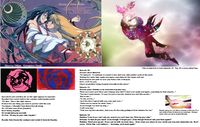
Just like the ending with Kyoko and Sayaka, there is speculation with fans regarding Homura's relationship with Madoka and her willingness to sacrifice it all for her. On this new world Sayaka dies but she has no regrets, and Kyoko laments her death just when they have become friends (fans have interpreted this in many ways).
To read more details, see here.
Sayaka's Concert Scene
- Regarding Sayaka's death. Madoka explains that she could have changed Sayaka's fate but not without changing Kyousuke's as well. Madoka tells Sayaka that she left their fate unchanged to respect her sacrifice, Sayaka agrees with Madoka's decision.
- Many fans dislike what happened to Sayaka on the grounds that she sacrificed her life for someone that wouldn't reciprocate any romantic feelings for her. There is also the issue that she left a family behind (albeit we don't know what kind of relationship she had with them).
- Still, it is because of these reasons that some people are interpreting Sayaka's sacrifice to be either misguided or beautiful and it is open to interpretation.
- Many fans dislike what happened to Sayaka on the grounds that she sacrificed her life for someone that wouldn't reciprocate any romantic feelings for her. There is also the issue that she left a family behind (albeit we don't know what kind of relationship she had with them).
- Sayaka's sacrifice and death is much closer to the Little Mermaid's story, in this version, Sayaka passes away with no regrets or hatred toward anyone, only sadness but she accepts it willingly. Unlike Episode 8 where Sayaka felt great despair and regret toward her decision.
- Sayaka's death is also important to illustrate the changes on the new magical girl system, not only does it show that death is still possible for magical girls, but it also wraithstrates that Madoka has a presence in the system to help the spirits of the death to pass away. There are still many questions and mysteries regarding these changes but the impact allows the viewer to see that there is closure for characters like Sayaka.
- Many fans suggest that Sayaka's soul, although erased from the world, now resides in the same plane of existence that Madoka inhabits, where she will watch over all the other magical girls along with Madoka.
- Alternatively, Madoka's presence is there to help Sayaka to move on, to help her ease her ending so she would have no regrets. This would more line up with the confirmation that Madoka guides the souls of all dead magical girls to "another universe" after death.
Magazine Articles
Initial broadcast and delays
This episode was scheduled to air on 24 March 2011 but has been pulled due to the 2011 Sendai earthquake and tsunami. On April 10, 2011 it was announced that Madoka was scheduled to resume its broadcasting on the 21 of April 2011 and it would air the last two episodes back-to-back.
- MBS (Kansai area): 11th & 12th episodes on Thursday, April 21 at 26:40 (effectively Friday, April 22 at 2:40 a.m.)
- TBS (Tokyo's Kanto area): 10th, 11th, and 12th episodes on Thursday, April 21 at 27:00 (Friday, April 22 at 3:00 a.m.) TBS had preempted its airing of the 10th episode due to its news coverage of the earthquake.
- CBC (central Japan): 10th, 11th, and 12th episodes on Sunday, April 24 at 26:45 (Monday, April 25 at 2:45 a.m.).
- The fact that this episode aired during Good Friday, and the similarity between both events, led to jokes and far-fetched speculation from the fanbase.
Gallery
Madoka as a witch
-
Madoka's corrupted Soul Gem
-
The Ultimate Witch's arms forming
-
Madoka's Ultimate Witch form wearing a mask
Madoka as a Magical Girl
-
Madoka's Ultimate Magical Girl form
-
Close up
-
Madoka with wings
End sequence
-
Don't forget. Always, somewhere, someone is fighting for you. As long as you remember her, you are not alone.
-
All the main characters of the series
-
All the magical girls of the show, including the girls that only were shown as witches.
Homura's new power
-
Homura's new weapon, a bow much like Madoka's
-
Homura with angel-like wings
-
Homura with witch-like wings
Other
-
The magic sigil that Madoka uses to destroy witches
-
Madoka petting an Anthony
-
Kyubey stated that Madoka the human being has ceased to exist physically and in memory. He was only partially right
-
Grief Seeds from Witches have been replaced with Grief Cubes(?) from Wraiths
-
Unaired episode 12 end card by Ume Aoki.
Official Sketches
-
A concept drawing of the Wraiths (魔獣 Majū).
-
Puella Magi Madoka Magica Official Guidebook "You Are Not Alone"
Annotations
- ↑ Normally such a wish would be impossible to fulfill as stated by Kyubey, "You are the center of karmic destiny from many different timelines. So, no matter how enormous your wish, it most definitely will come true." The system as it is set up would normally reject granting such a wish as it has to be proportional to a girl's cosmic karma or power (actually, it is possible that the wish would be granted as Kyubey is still contractually obligated to grant any wish, but it would instead go unfulfilled as it would fail to meet the required energy input to attain the desired output). Normally, a girl like Madoka with an ordinary life would only be allowed to attain an ordinary but still powerful wish, but in Madoka's case it is an exception because she is an anomaly. Usually people with large karmic burden are historical figures that posses a destiny that could change history, but even at that level it would still be quite literally impossible for such a wish to be fulfilled as it would fail to meet the energy requirement to have such a powerful wish granted. It is thanks to Homura's countless time travels that Madoka has accumulated such a large reservoir of cosmic karma, the amount was unprecedented enough to grant her a wish that was powerful enough to rewrite the current laws of the universe that concluded with a paradox. This is an event that literally goes against all odds of ever repeating again. No other girl in history could have such a wish granted, not unless their power/karma was proportional to it, and that doesn't happen naturally.
External links
- Episode 12 summary at official website (Japanese)
- An unofficial FAQ about the ending
- Birth of a Goddess, Madoka’s Path to Nirvana – A Study of Buddhism
- Puella Magi Madoka Magica voted #1 Shaft Anime by Shaft fans
- Episode 12 will have a bonus extra: Director's cut
| Puella Magi Madoka Magica | ||
|---|---|---|
| Previous Episode | Current Episode | Continued in |
| Episode 11 The Only Thing I Have Left to Guide Me |
Episode 12 My Very Best Friend |
Wraith Arc: Chapter 1 |
